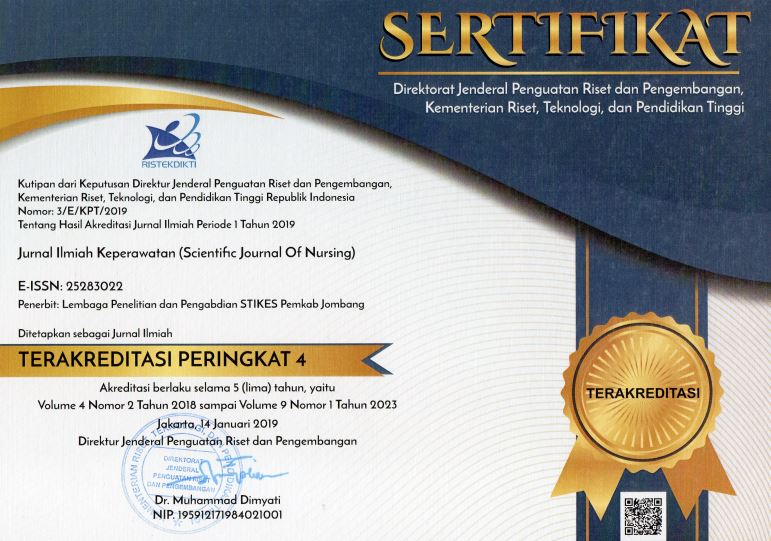EVALUASI PELAKSANAAN KOMUNIKASI EFEKTIF “STATUS PRESENT” PADA HANDOVER EMERGENCY DI RSU HAJI SURABAYA
Evaluation of Effective Communication of “Present Status” in Emergency Handover in Haji General Hospital Surabaya
DOI:
https://doi.org/10.33023/jikep.v6i1.444Keywords:
Komunikasi efektif, SBAR, handover emergencyAbstract
ABSTRAK
Introduction : Pelaksanaan pengisian komunikasi efektif SBAR pada handover emergency harus sesuai dengan standard. Dari hasil evaluasi dokumen rekam medis menunjukkan bahwa indikator instrumen pada status present belum terdokumentasi dengan baik. Tujuan dari penelitian ini adalah menyusun pengembangan instrumen komunikasi efektif SBAR pada handover emergency
Method : Desain penelitian menggunakan deskriptif. Sampel penelitian ini adalah 150 dokumen rekam medis dan 15 partisipan dalam proses FGD. Partisipan dipilih menggunakan purposive sampling. Analisa data menggunakan analisis deskriptif. Result: Instrumen komunikasi efektif (status present) pada handover emergency banyak yang tidak sesuai standar, Penerapan pengisian status present pada handover emergency di ruang RSU Haji Surabaya menunjukkan bahwa seluruh responden memiliki kemampuan yang cukup dalam mengisi format status present
Discussion : Komunikasi efektif status present pada penelitian ini adalah instrumen handover yang mencakup seluruh informasi dan perencanaan serta memuat kondisi pasien terkini yang dibutuhkan oleh perawat IGD. Instrumen komunikasi efektif SBAR ini dilakukan untuk meningkatkan mutu pelayanan keperawatan dan mencegah terjadinya kejadian tidak diharapkan pada pasien.
Kata Kunci : komunikasi efektif, status present, handover emergency
Downloads
References
Almas, S., Yegane, F., Shahrami, A., & Hatamabadi, H. R. (2017). Clinical Information Transfer between EMS Staff and Emergency Medicine Assistants during Handover of Trauma Patients. (October), 1–7. https://doi.org/10.1017/S1049023X17006562
Bakon, S., & Millichamp, T. (2017). Optimising the emergency to ward handover process : A mixed methods study. Australasian Emergency Nursing Journal, 20(4), 147–152. https://doi.org/10.1016/j.aenj.2017.10.001
Ballard, S. A., Peretti, M., Lungu, O., Voyer, P., Tabamo, F., Alfonso, L., … Wilchesky, M. (2017). Factors affecting nursing staff use of a communication tool to reduce potentially preventable acute care transfers in long-term care. Geriatric Nursing, 1–5. https://doi.org/10.1016/j.gerinurse.2017.03.012
Campbell, D., & Dontje, K. (2018). Implementing Bedside Handoff in the Emergency Department: A Practice Improvement Project. Journal of Emergency Nursing, 1–6. https://doi.org/10.1016/j.jen.2018.09.007
Croos, S. (2014). a respite perspective. 23(13), 733–737.
Defenbaugh, N., & Chikotas, N. E. (2016). Nurse Education in Practice The outcome of interprofessional education : Integrating communication studies into a standardized patient experience for advanced practice nursing students. Nurse Education in Practice, 16(1), 176–181. https://doi.org/10.1016/j.nepr.2015.06.003
Departemen kesehatan. (2017). Peraturan menteri kesehatan republik indonesia nomor 11 tahun 2017. Jakarta: departemen kesehatan.
Downey, L. V., Zun, L., & Burke, T. (2013). What constitutes a good hand offs in the emergency department: A patient’s perspective. International Journal of Health Care Quality Assurance, 26(8), 760–767. https://doi.org/10.1108/IJHCQA-03-2012-0028
Hidayat, A. A. (2014). Metodologi Penelitian Kebidanan & Teknik Analisis Data Contoh Aplikasi Studi Kasus. Jakarta: Salemba Medika.
Kedokteran, K. (2006). Komunikasi Efektif Dokter-Pasien.
Kementerian Kesehatan. (2011). Peraturan Menteri Kesehatan Republik Indonesia nomor 1691/menkes/per/viii/2011.
Kerr, D., Klim, S., Kelly, A. M., & Mccann, T. (2016). Impact of a modified nursing handover model for improving nursing care and documentation in the emergency department: A pre- and post-implementation study. International Journal of Nursing Practice, 22(1), 89–97. https://doi.org/10.1111/ijn.12365
Komisi Akreditasi Rumah Sakit. (2017). Standar Nasional Akreditasi Rumah Sakit Edisi 1.
Lyphout, C., Bergs, J., Stockman, W., Deschilder, K., Duchatelet, C., Desruelles, D., & Bronselaer, K. (2017). Patient safety incidents during interhospital transport of patients : A prospective analysis. International Emergency Nursing, (July), 1–5. https://doi.org/10.1016/j.ienj.2017.07.008
Moy, N. Y., Lee, S. J., Chan, T., Grovey, B., Boscardin, W. J., Gonzales, R., & Pierluissi, E. (2014). Methods, tools, and strategies development and sustainability of an inpatient-to-outpatient discharge handoff tool: A quality improvement project. Joint Commission Journal on Quality and Patient Safety, 40(5), 219–227. https://doi.org/10.1016/S1553-7250(14)40029-1
Mundakir. (2016). Komunikasi Pelayanan Kesehatan. Yogyakarta: Indomedia Pustaka.
Nursalam. (2016). Manajemen Keperawatan (5th ed.; Lestari Peni Puji, Ed.). Jakarta: Salemba Medika.
Pawlikowska, T., Zhang, W., Griffiths, F., & Dalen, J. Van. (2012). Patient Education and Counseling Verbal and non-verbal behavior of doctors and patients in primary care consultations – How this relates to patient enablement. Patient Education and Counseling, 86(1), 70–76. https://doi.org/10.1016/j.pec.2011.04.019
Permenkes. (2017). KESELAMATAN PASIEN. 感染症誌, 91, 399–404.
Purnama Deni. (2016). Komunikasi, Informasi, dan Edukasi Efektif (Hanafi Irham, Ed.). Yogyakarta: Betha Grafika.
Rahman Fauzie. (2017). Komunikasi Kesehatan (Nugroho Adi, Ed.). Yogyakarta: Pustaka Panasea.
Streeter, A. R., & Com-, A. (2017). Nurse Handoff Communication. Seminars in Oncology Nursing, 33(5), 536–543. https://doi.org/10.1016/j.soncn.2017.10.002
Watkins, L. M. (2014). Handoff Communication From the Emergency Department to Primary Care. 36(1), 44–51. https://doi.org/10.1097/TME.0000000000000003
Webster, D. (2014). Using Standardized Patients to Teach Therapeutic Communication in Psychiatric Nursing. Clinical Simulation in Nursing, 10(2), e81–e86. https://doi.org/10.1016/j.ecns.2013.08.005
Published
How to Cite
Issue
Section
Authors who publish with Jurnal Ilmiah Keperawatan (Scientific Journal of Nursing) agree to the following terms:
- Authors retain copyright and grant Jurnal Ilmiah Keperawatan (Scientific Journal of Nursing) the right of first publication with the work simultaneously licensed under a Creative Commons Attribution 4.0 International License that allows others to remix, adapt and build upon the work with an acknowledgment of the work's authorship and of the initial publication in Jurnal Ilmiah Keperawatan (Scientific Journal of Nursing).
- Authors are permitted to copy and redistribute the journal's published version of the work (e.g., post it to an institutional repository or publish it in a book), with an acknowledgment of its initial publication in Jurnal Ilmiah Keperawatan (Scientific Journal of Nursing).









